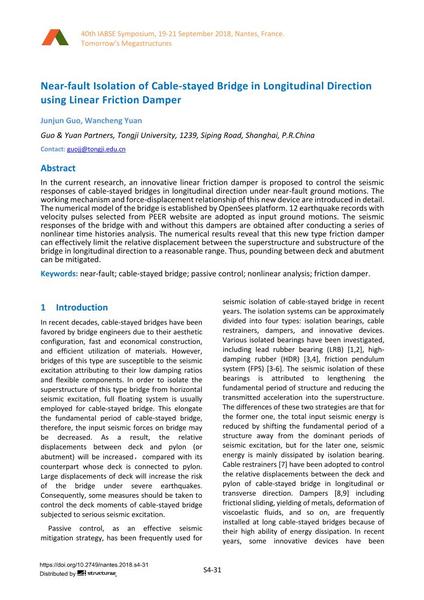Near-fault Isolation of Cable-stayed Bridge in Longitudinal Direction using Linear Friction Damper

|
|
|||||||||||
Bibliographic Details
| Author(s): |
Junjun Guo
(Guo & Yuan Partners, Tongji University, 1239, Siping Road, Shanghai, P.R.China)
Wancheng Yuan (Guo & Yuan Partners, Tongji University, 1239, Siping Road, Shanghai, P.R.China) |
||||
|---|---|---|---|---|---|
| Medium: | conference paper | ||||
| Language(s): | English | ||||
| Conference: | IABSE Symposium: Tomorrow’s Megastructures, Nantes, France, 19-21 September 2018 | ||||
| Published in: | IABSE Symposium Nantes 2018 | ||||
|
|||||
| Page(s): | S4-31 | ||||
| Total no. of pages: | 8 | ||||
| DOI: | 10.2749/nantes.2018.s4-31 | ||||
| Abstract: |
In the current research, an innovative linear friction damper is proposed to control the seismic responses of cable-stayed bridges in longitudinal direction under near-fault ground motions. The working mechanism and force-displacement relationship of this new device are introduced in detail. The numerical model of the bridge is established by OpenSees platform. 12 earthquake records with velocity pulses selected from PEER website are adopted as input ground motions. The seismic responses of the bridge with and without this dampers are obtained after conducting a series of nonlinear time histories analysis. The numerical results reveal that this new type friction damper can effectively limit the relative displacement between the superstructure and substructure of the bridge in longitudinal direction to a reasonable range. Thus, pounding between deck and abutment can be mitigated. |
||||
| Keywords: |
cable-stayed bridge non-linear analysis Near-Fault Friction damper passive control
|
||||
